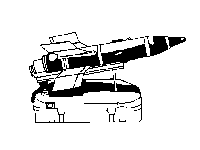
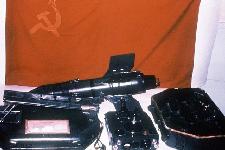
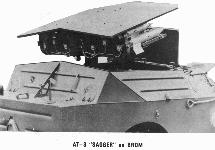
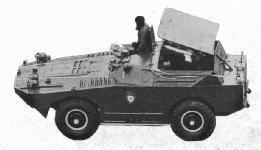

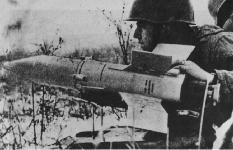
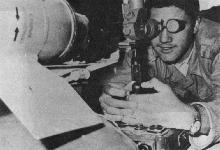
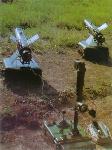
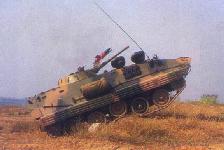
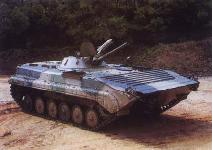





The wire-guided 9M14M Malutka [Tiny or Little Baby] SAGGER, also known by the US designation AT-3, was first seen in 1961. The SAGGER is a wire-guided antitank guided missile with a shaped-charge HEAT warhead. It is more compact than the earlier AT-1 /SNAPPER and AT-2/SWATTER ATGMs, but carries an equally powerful warhead. Antiarmor missiles are used, above all, as helicopter weapons on Mi-2 and Mi-8 helicopters and thus are modifications of army missiles. Introduced in 1961, the SAGGER was smaller but just as effective as its predecessors the AT- 2 SWATTER and AT-1 SNAPPER. It has now been withdrawn from ordnance.
The SAGGER may be employed as a man-packed missile, on vehicles, and from rotary-wing aircraft. AT-3 is classed by weight as portable (21-40 kg), rather than manportable (<21 kg). The launcher is also a missile carry case.
The manpack version is carried in a fiberglass "suitcase", is launched from a rail attached to the lid of the case on a hinged support, and is fired and guided by a control box with firm button, periscope sight, and control stick.
On BRDM/BRDM-2 scout vehicles launch rails are mounted on the underside of the retractable armored cover, with eight additional missiles carried inside the vehicle. The BMP and BMD combat vehicles both have a single launch rail mounted above the 73-mm main gun and carry a total of four and three missiles respectively. The retractable launcher on the BRDM-2 vehicle has the ability to traverse 70 degrees to the left or right with elevation varying from 3.5 to 17 degrees.
The Mi-2/HOPLITE helicopter can carry four SAGGERs on the sides of its cabin. The Mi-8/HIP F carries six SAGGERs, and some export models of the Mi-24/HIND carry four SAGGERs on wingtip launchers.
The 9M14M missile weighs 10.9 kg, is 860 mm long, has a body diameter of 125 mm and a wing span of 393 mm. Its maximum range is 3000 m and its minimum firing distance is 500 mm. With an average speed being 120 m/s, the missile is slow, taking 25 seconds to reach its maximum range of 3000 meters.
The SAGGER is capable of engaging targets at ranges of 500 to 3,000 meters and can penetrate over 400 mm of armor. As with the SWATTER, the SAGGER uses manual command to line of sight (MCLOS) guidance system in which the operator must observe both missile and target and guide the one towards the other. The improved SAGGER-C was fitted with semi-automatic command line of sight (SACLOS) guidance to serve as an interim until the AT-5 SPANDREL and AT-6 SPIRAL entered service. The guidance panel can be located up to 15 meters from the launcher, and can control up to four launchers. If a target is <1,000 meters from launcher, the operator can joystick the missile to target without using optics. The guidance elevation (�) is -5/ +10. Because the module is small and can be shifted, elevation and field of view are operationally unlimited. Improved versions can be used on older launchers, but in the MCLOS mode.
The SAGGER A or B gunner must visually track target and missile simultaneously, which requires extensive training and constant practice. Although the missile leaves the launcher armed and can detonate and kill at very short range, it can be captured by the gunner only at ranges of 500 to 800 meters. Under combat conditions, however, most gunners probably will be able to engage targets successfully only between 1,000 and 3,000 meters. The missile has a very long flight time to the target (12.5 seconds to 1,500 meters; 25 seconds to 3,000 meters), and evasive action is effective against it, especially at long ranges. Although a SAGGER launching gives off a cloud of gray smoke and a loud roar, this signature is difficult to detect on the battlefield. The wire-guided missile is invulnerable to electronic countermeasures and has a very small percentage of malfunctions.
The antitank platoon of a BTR-equipped motorized rifle battalion (MRB) has two ATGM squads with two manpack SAGGER firing teams (two missiles each). In each three-man team, the gunner carries a suitcase containing the control box, and two assistant gunners each carry one missile in a suitcase. One of the assistant gunners is also an RPG-7 gunner. One missile can be set up, checked out, and fired in five minutes (1 2 to 1 5 minutes for all four missiles). Using a tour-position selector switch on the control box, each gunner can fire up to four missiles consecutively. Both gunners can remotely fire missiles from positions up to 15 meters from the launchers. For targets at less than 1,000 meters, the missile can be guided by eye; for longer ranges, the 8x magnifying periscopic sight must be used. The RPG-7 gunner usually is deployed 1 50 to 200 meters in front of the SAGGER position to cover targets inside the minimum SAGGER range of 500 meters. The antitank platoon also has two SPG-9s which may be employed with the manpack SAGGERs.
BRDM/BRDM-2 SAGGERs are found in the antitank battery of motorized rifle regiments, in the antitank battalion of motorized rifle and tank divisions, and in the antitank regiment of artillery divisions. The BRDM/BRDM-2 vehicles have a reaction time of one minute to fire from a completely buttoned-up mode. Six missiles can be fired without reloading, and eight additional missiles are carried inside the vehicle. Successive missiles can be fired and tracked within five seconds of the previous missile's impact. The gunner can operate either from within the vehicle or from a remote position up to 80 meters away. The two-man crew (commander/gunner and driver) also has assault rifles and an RPG-7 antitank grenade launcher.
SAGGERs are also found in airborne units. The manpack version is found in the antitank platoon of a non-BMD-equipped parachute company and also in the antitank battery of a non-BMD-equipped airborne battalion. BRDM/BRDM-2 SAGGERs are found in the ATGM battery of the BMD-equipped airborne regiment.
Copies include North Korean Susong-Po, Taiwanese Kun Wu, and the Chinese copy, Red Arrow-73/HJ-73, with indigenous guidance. The "Hongjian (Red Arrow)-73," China's first-generation anti-tank missile developed in the mid-1980s, had an estimated hit probability of 70 percent. POLK is a Slovenian Portable Anti-armor Launching Set that includes a new launcher, guidance panel with binocular sight, and 3 ATGMs similar to AT-3C Improved (nose probes and lower smoke signature). With a nose probe and improved propellant, the MCLOS-guided ATGM can reach maximum range in 25 sec and penetrate 580 mm. A Russian AT-3c/Improved (SACLOS) has similar capabilities.
Iran makes a copy of the Russian AT-3 9M14M (Sagger or Ra�ad) anti-tank guided missile. An improved version of RAAD missile, RAAD-T missile, incorporates a tandem warhead armament system and due to new airframe, its maneuverability increased considerably. Irrespective of the year and place of production, all versions of RAAD missiles can be upgraded to the new version. The RAAD-T weapon system is a portable anti-tank guided missile, which is used to attack any armored fighting vehicle including those with Explosive Reactive Armor (ERA). In field operations, only by one ground guidance equipment, up to four missiles on their launchers can be shot, each in every 30 seconds. The system Safety and Arming Device (SAD) provides a high level of safety during the transportation and handling besides a reliable arming in operation. It is transported in new packing and tested with new equipment. By impacting the target, even at high angles of attack, explosion of the front charge, will remove the Explosive Reactive Armor (ERA) and after a delay time, the main charge will be exploded and the tank distrusted.The Slovenian Iskra TS-M thermal sight is available, with detection at 3,000 meters and recognition at 1,800 meters. Any AT-3 can be modernized to Malyutka-2 with replacement of warhead and or replacement of specific warhead and motor components.
Specifications | |
| Alternative Designations | Malyutka Complex |
| Launching Platforms | Manpack BMD BMP BRDM/BRDM-2 Mi-8 Hip Mi-24 Hind |
| Date of Introduction | 1963 |
| Proliferation | At least 45 countries, including: Former Soviet Republics, Afghanistan, Algeria, Angola, Bulgaria, Czechoslovakia, Cuba, Egypt, Ethiopia, Hungary, Iraq, India, North Korea, Libya, Mozambique, Poland, Romania, Syria, Uganda, Vietnam, Yugoslavia, Zambia. |
| Description | |
| Crew | 3 |
| Primary Mount | Ground mount on "suitcase" launcher |
| Alternate Mounts | Rail on BMP-1, BMD-1, BRDM, BRDM-2 etc. |
| Weight Overall, Excluding Missile (kg) | 30.5 launcher + guidance |
| Length Overall in Firing Position (m) | 0.86 with AT-3/a/b/c 1.02 with Malyutka-2 |
| Height Overall In Firing Position (m) | INA |
| Width Overall In Firing Position (m) | INA |
| ARMAMENT | |
| Launcher Name | 9P111 Case launcher |
| Launch Method | Rail on case |
| Elevation (�) | Fixed for launcher |
| Rate of Launch (missiles/min) | 2 |
| Reaction Time (sec) | INA |
| Emplacement Time (min) | 1.7 POLK set |
| Displacement Time (min) | INA |
| Ready/Stowed Missiles | 4/0, 3/0 POLK set |
| FIRE CONTROL | |
| FCS Name | 9S415/9S415M/9S415M1 guidance panel |
| Guidance | MCLOS (9S415/-M panel), SACLOS |
| Command Link | Wire |
| Beacon Type | Incandescent infrared bulb (SACLOS) |
| Tracker Type | N/A for MCLOS, flare tracker for SACLOS |
| Susceptible To Countermeasures | EO jammers, smoke, counterfire |
| Counter-countermeasures | Offset guidance panel, laser filters |
| Rangefinder | INA |
| Frequency | INA |
| Counter-countermeasures | INA |
| Sights w/Magnification | |
| Gunner | |
| Day | 9Sh16, 8x |
| Field of View (�) | 22.5 |
| Acquisition Range (m) | 4000 |
| Night | Available |
| Field of View (�) | N/A |
| Acquisition Range (m) | N/A |
| AMMUNITION | |
| Antitank Guided Missiles | |
| Name | AT-3, -3a, -3b/SAGGER |
| Alternative Designations | Malyutka, Malyutka-M |
| Missile Weight (kg) | 10.9 |
| Warhead Type | Shaped Charge (HEAT) |
| Armor Penetration (mm) | 400 |
| Minimum/Maximum Range (m) | 500/3,000 |
| Probability of Hit (%) | 70 against moving tanks |
| Average Velocity (m/s) | 115 |
| Time of Flight to Max Range (sec) | 26 |
| Name | AT-3c/SAGGER |
| Alternative Designations | Malyutka-P |
| Missile Weight (kg) | 11.4 |
| Warhead Type | Shaped Charge (HEAT) |
| Armor Penetration (mm) | 520 |
| Minimum/Maximum Range (m) | 500/3,000 |
| Probability of Hit (%) | 90 (SACLOS) |
| Average Velocity (m/s) | 115 |
| Time of Flight to Max Range (sec) | 26 |
| Name | Malyutka-2 |
| Alternative Designations | Malyutka (Modernized) |
| Missile Weight (kg) | 12.5 |
| Warhead Type | Tandem Shaped Charge (HEAT) |
| Armor Penetration (mm) | 800 |
| Minimum/Maximum Range (m) | 500/3,00 |
| Probability of Hit (%) | 90 (SACLOS) |
| Average Velocity (m/s) | 130 |
| Time of Flight to Max Range (sec) | 23 |
| Other Missiles | Malyutka (Modernized) HE, AT-3c Imp, POLK |









